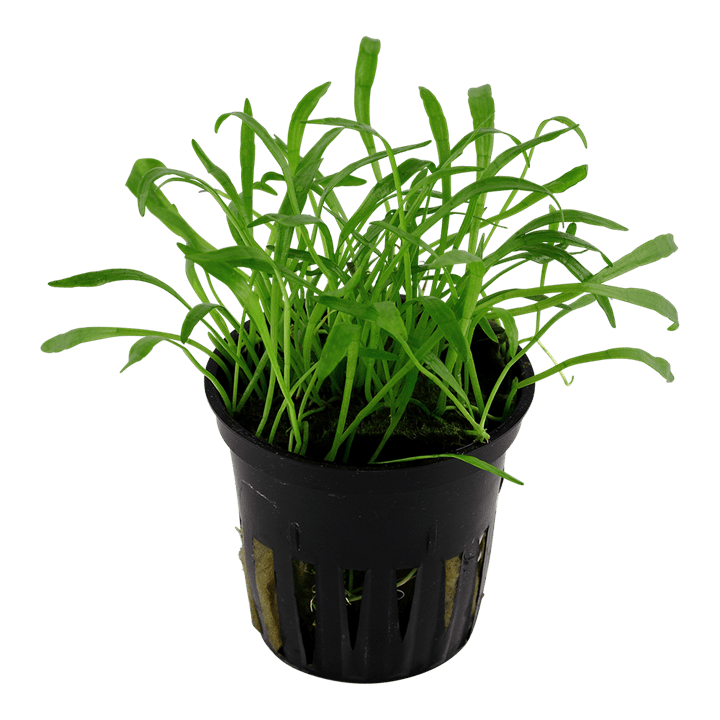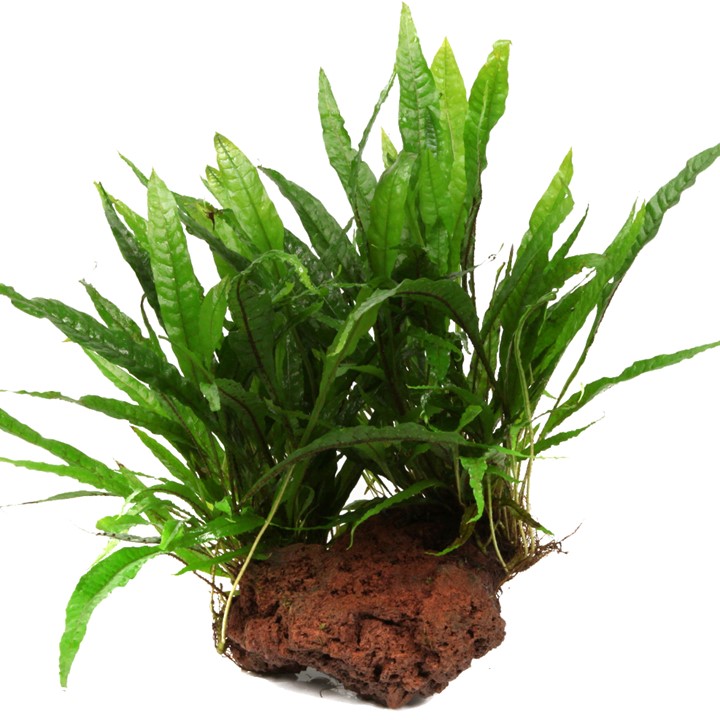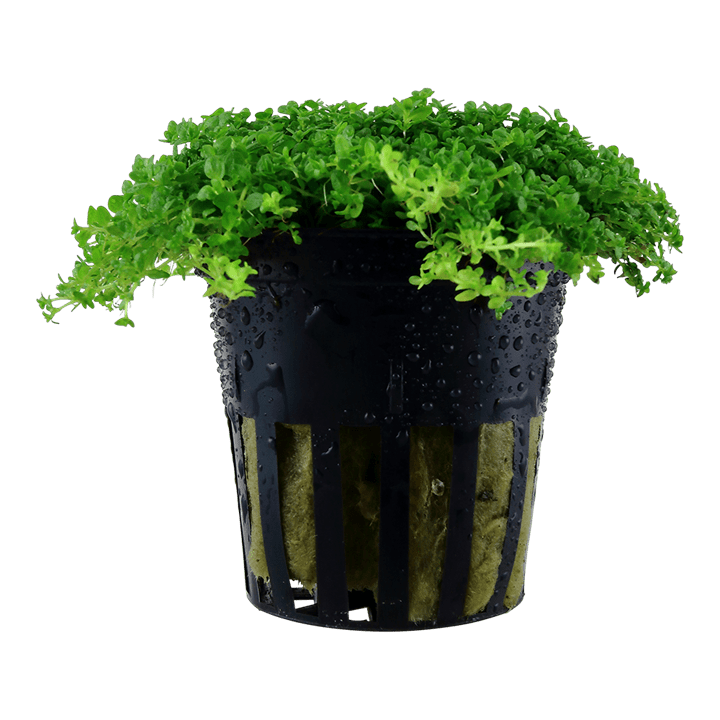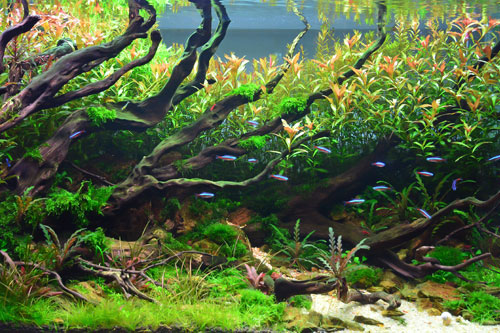by John Tullock
Are you the type of person that appreciates a real challenge every now and then? If so, I suggest you look into designing and building a paludarium tank.
What is a Paludarium?
According to the Aquatic Gardeners Association, a paludarium tank is an “aquarium with above and below water aquascaping.” This is not to be construed, as is explained on the AGA web site, as a “terrarium with water in the bottom.”
In other words, as much attention should be paid to designing and planting the underwater portion as is given to creating the terrestrial portion of the display. Having been an aquarium enthusiast for decades, I have attempted a paludarium on a few occasions, and have never been really happy with the results.
In thinking about the reasons for this, one of the biggest problems is the difficulty of building a display in a smaller tank.
How to Make a Beautiful Paludarium Display
If you’re wondering how to make a paludarium display, here are my suggestions:
- • Tank Size. What is required for a paludarium tank setup is a tank that is approximately twice as tall as the desired final aquatic portion, or taller. Most aquarium hobbyists would consider a tank much less than 12 inches deep to be pretty confining, so a paludarium needs to be about 24 inches tall (or taller) in order to accommodate both water and air-dwelling plants. The added height means lighting above the paludarium must be intense, to suffice both the terrestrial plants and those living under the water.
- • Lighting. I recommend investigating the PAR values reported for various lighting systems, as well as taking into account the needs of the plants you are considering, before selecting lighting equipment.
- • Filtration. The aquatic portion of the paludarium will require filtration and, possibly, carbon dioxide supplementation, just as if it were a free-standing aquarium holding the same quantity of water.
- • Substrate. Substrate selection and hardscape should complement the planned terrestrial portion of the display. Which brings us to the most important consideration of all: make a plan!

Planning Your Paludarium Tank Setup
More than any other aquarium project, a paludarium will benefit from you preparing a detailed plan, preferably to scale.
I recommend making your mistakes on paper before you make them during construction. A paludarium can involve considerable expense and effort.
Save both with a carefully laid out plan.
You’ll want to consider the following:
- • The number of species you want to keep in your paludarium.
- • The overall layout you want to have (e.g. are you trying to evoke the look of a South American riverbed?)
- • Are you planning on incorporating a waterfall?
- • Having a tank that is a minimum of 10 gallons.
Paludarium Tank Features:
The Canopy
The top part of your paludarium is what’s known as the canopy. Your taller plants, and any amphibians or reptiles that like to bask will enjoy thriving in the canopy.
In addition, many paludarium enthusiasts use a waterfall as the focal point of their tank. Paludarium waterfalls often spill over at the top and create a mini river or lake below, simulating a waterfall in real life.
The Land
Most of your rocks, soil, driftwood, sand, and plants will be placed or planted on the ground.
When planning your paludarium setup, keep in mind that you’ll need plenty of space for your animals to fully dry off, roam around, sleep, and eat.
As you build your paludarium, consider the types of plants you’ll want to use to complement the aquatic plants below (we’ll discuss plants in just a bit).
The Water
The lowest part of your paludarium tank is the water. This is of course where your fish and aquatic plants will thrive.
Not only does the water provide a living space for all your aquatic species, but it also hydrates and increases humidity levels in the paludarium overall.


Lilaeopsis brasiliensis
Photo credit: Tropica.com

Microsorum pteropus
Photo credit: Tropica.com

Hemianthus callitrichoides
Photo credit: Tropica.com
Plants for Your Paludarium
Plants are going to be a major part of your paludarium’s ecosystem.
While this is not an exhaustive list, this is just a start to get you thinking about the various species of aquatic, semi-aquatic, terrestrial, and epiphytic plants you can keep in your paludarium build:
Aquatic Plants
Here are some suggestions for paludarium aquatic plants:
- • Carpeting plants – Lilaeopsis brasiliensis
- • Foliage plants – e.g. Java Fern (Microsorum pteropus)
- • Floating plants – e.g. “Floating Crystalwort” (Riccia fluitans)
Semi-Aquatic Plants
These types of plants are able to thrive both in and out of the water:
- • Carpeting plants – Dwarf Baby Tears (Hemianthus callitrichoides)
- • Foliage plants – e.g. Cryptocoryne plants (e.g., C. lucens) or Bolbitis ‘Difformis‘ water fern.
- • Epiphytic plants – Anubias and Bucephalandra.
- • Mosses – Java Moss (Taxiphyllum barbieri) or Christmas Moss (Vesicularia montagnei).
Terrestrial Plants
- • Ferns –Nephrolepis, Davallia, Microsorum musifolium, etc.
- • Vines – Monstera, Syngonium, etc.
Epiphytic Plants
- • Neoregelia Bromeliad
- • Tillandsia Air plants
- • etc.
What’s the Difference Between a Paludarium, Aquarium, Terrarium, Vivarium & Riprarium?
With all the “ariums” in this hobby, it can be easily confusing to know what you want to build. Let’s go through the terminology and compare the paludarium to the aquarium, terrarium, vivarium, and riprarium.
Paludariums
Palus is a Latin word meaning “swamp” or “marsh.” As we discussed earlier, paludariums are essentially aquariums with aquascaping both below in the water, and above on the land. You can mix terrarium plants and aquarium plants seamlessly to bridge the gap and create a beautiful display that mimics an African, Asian, or South American lake or river.
Paludarium tanks are perfect for amphibious animals such as salamanders, frogs, invertebrates, and of course fish for the water.
Aquariums
Aquariums are completely water-based, fully submerged in water. Any type of tank that is completely filled with water and has plants, coral, animals, fish, or invertebrates in it is what is known as an aquarium.
Aquariums can be either saltwater or freshwater setups. There is a plethora of fish, shrimp, crab, and snail species to choose from.
Terrariums
Terrariums are essentially the opposite. They are like miniature gardens that are only filled with dirt and plants.
Technically, a terrarium is a plant ecosystem that is home to only dirt and plants – not living animals or invertebrates. If you are a plant person, you may love the idea of building a terrarium to care for your plants.

Planted Aquarium
Vivariums
If you add one or more animals to your terrarium, you get what is known as a vivarium. “Viv” means life. Thus, by definition, living animal(s) residing in an enclosure is what differentiates vivariums from terrariums.
Vivariums can be a desert or tropical setting, depending on the types of lizards, reptiles, or invertebrates you are planning on caring for. Frogs, geckos, skinks, anoles, snakes, monitors, bearded dragons, tarantulas, etc. are just some of the critters you can keep in a vivarium.
Ripariums
As their name implies, ripariums mimic the look of a coastline, shoreline, or wetlands. This type of tank features approximately 80% water and 20% land. Ripariums are different from paludariums because there likely are no completely dry areas at all.
If you’re interested in creating a partial land and water setup, you may want to consider recreating a shoreline of a river, stream, pond, or lake with a beautiful riparium.
Why Paludariums?
There is lots of appeal to a paludarium. They have various features of the other different types of tanks (aquarium, terrarium, vivarium, and riprarium) combined into one beautiful ecosystem, mimicking the jungles of South America, Asia, or Africa. As you hone your skills in aquascaping, you can create depth using various species of plants, wood, rocks, moss, and substrate to create a lush environment. Adding invertebrates, fish, and animals will bring life to the water and land setup.
At SevenPorts, we have dozens of rimless tanks, kits, lighting, heating, food, and other products to choose from for your dream paludarium or aquarium setup. Contact our team today at (626) 333-5372 for more information about how to build your dream paludarium.
